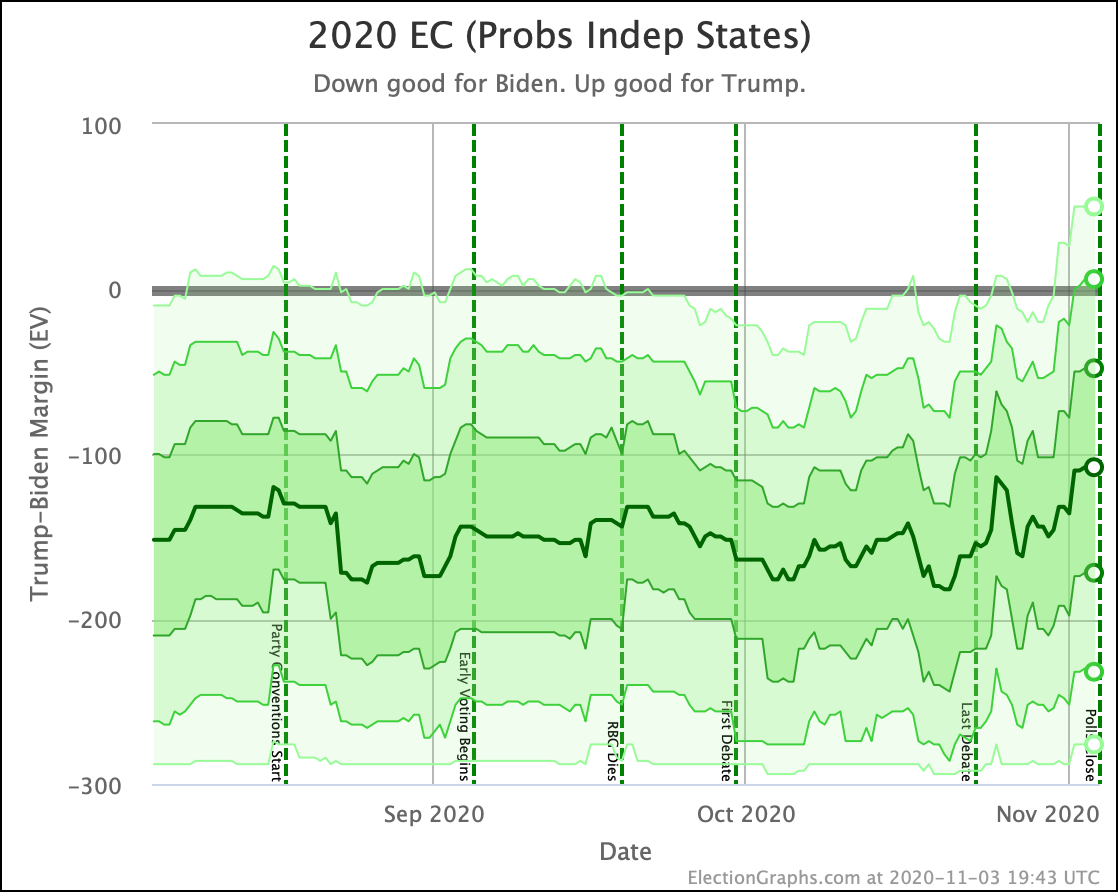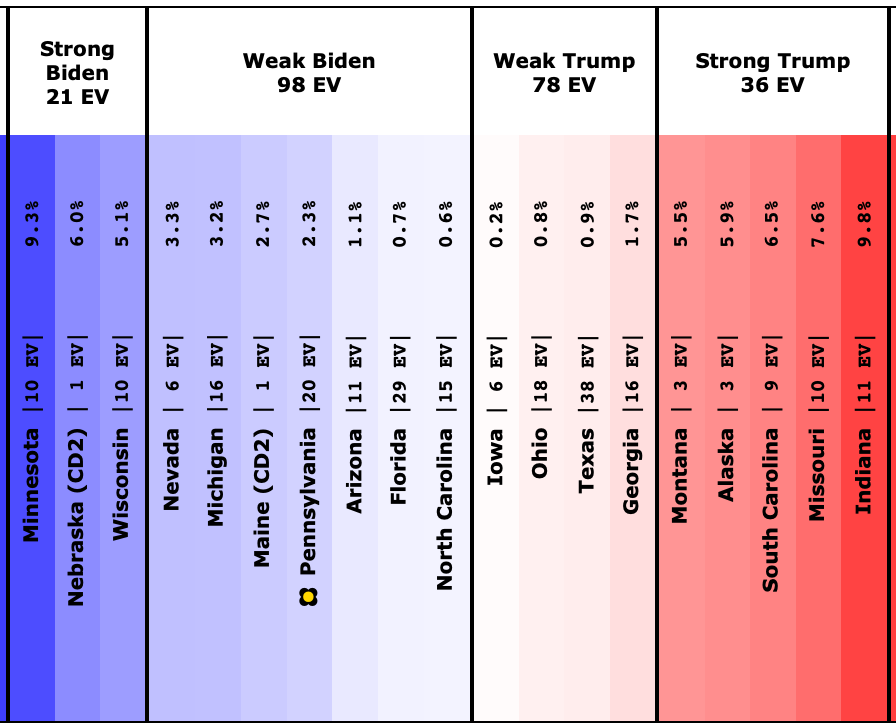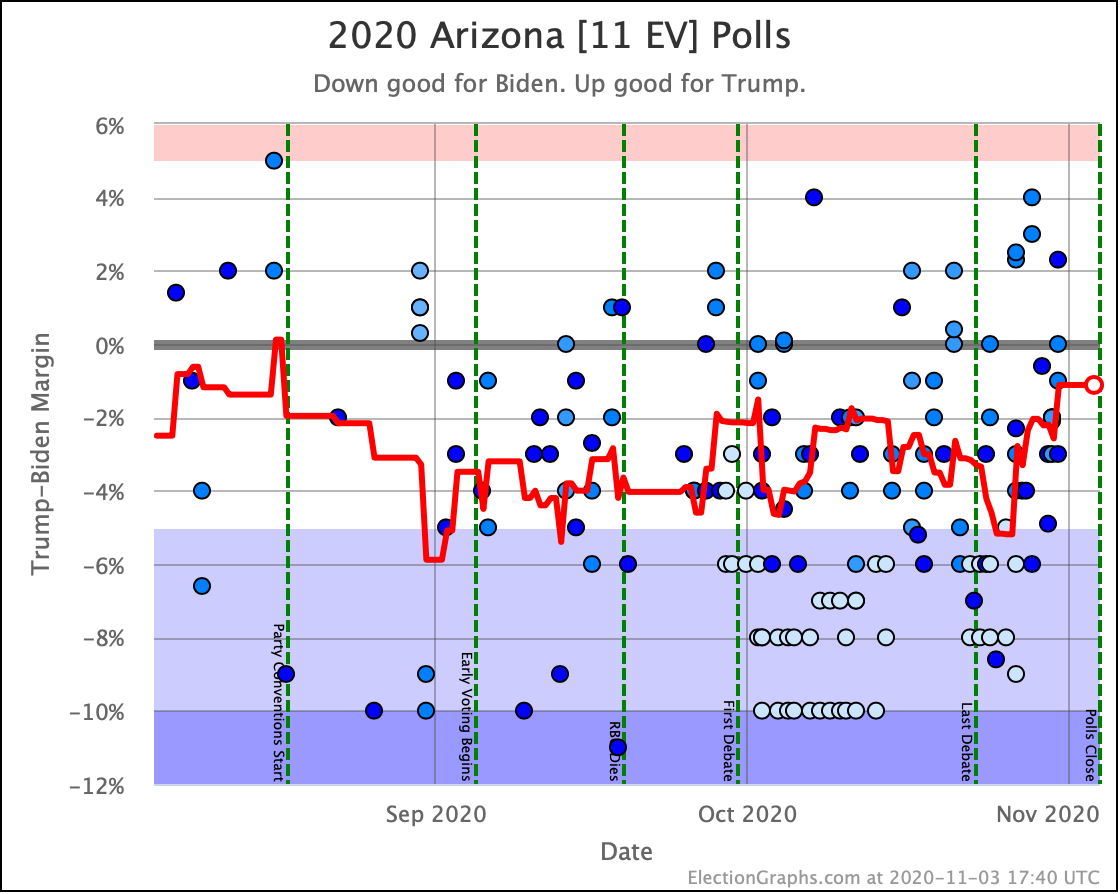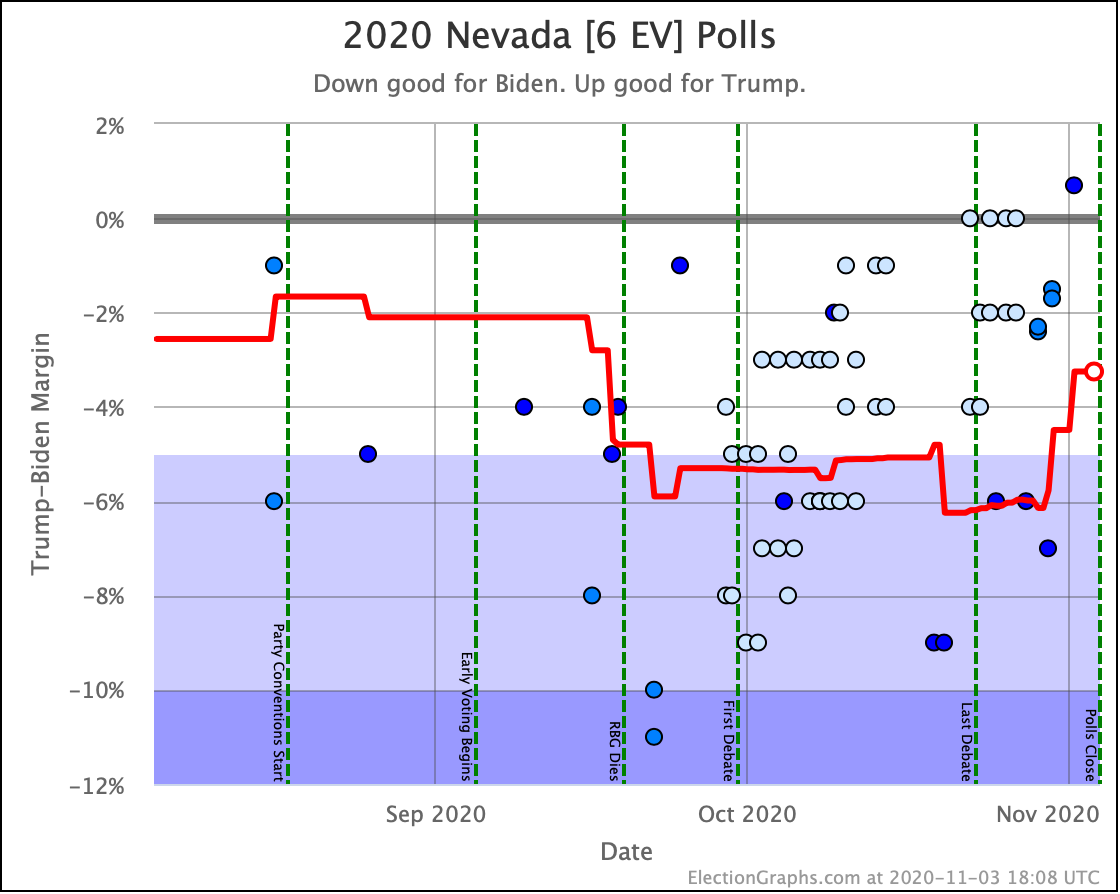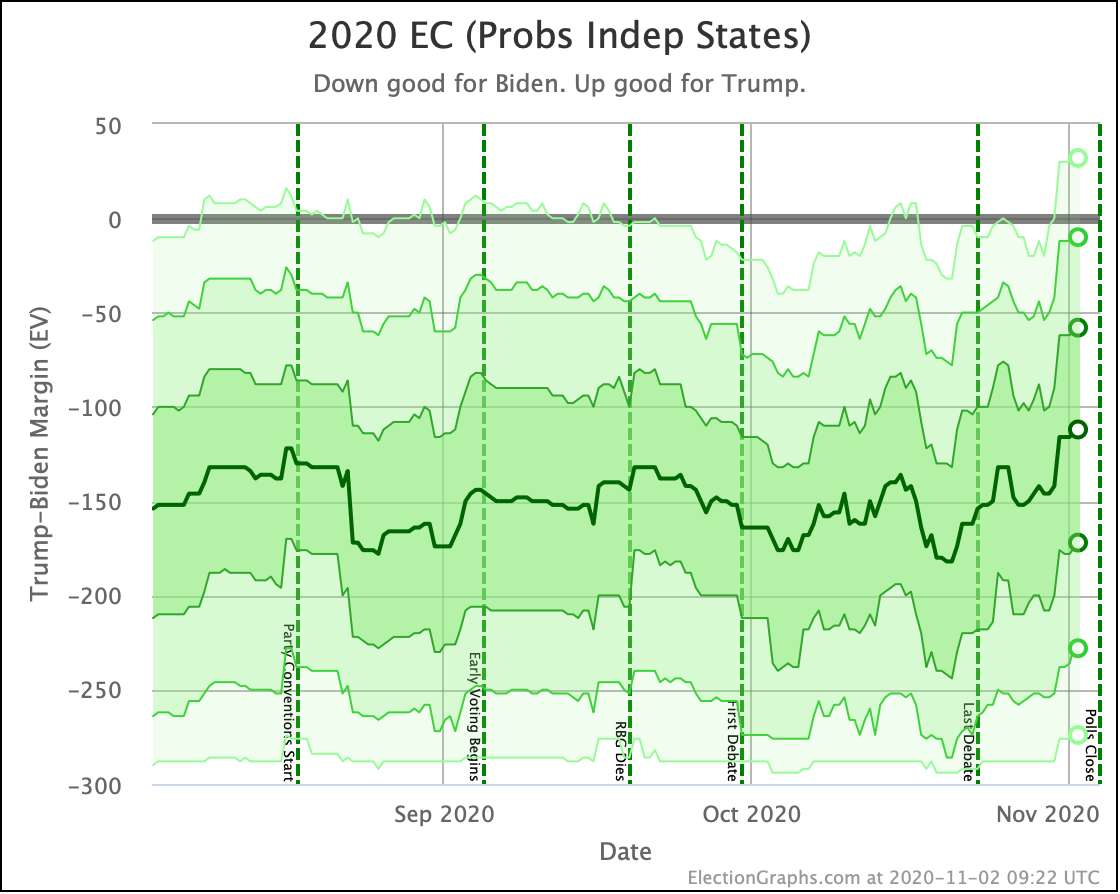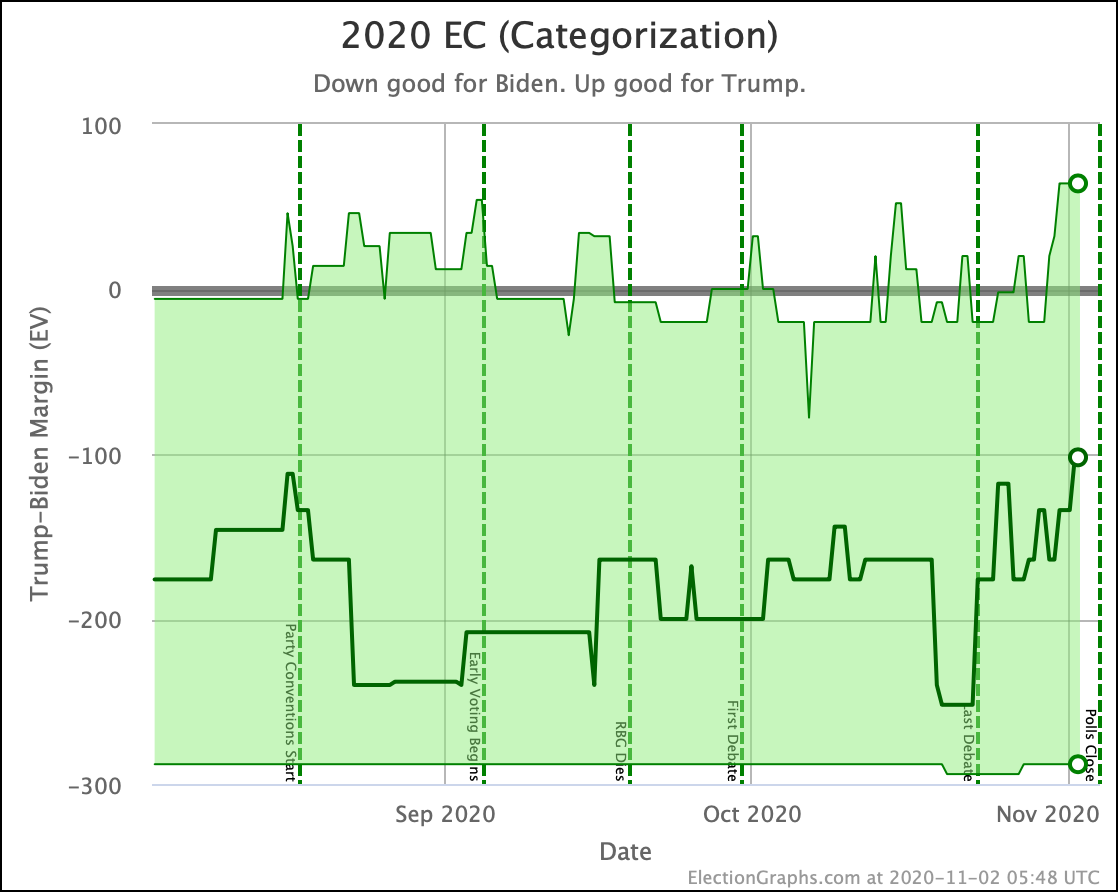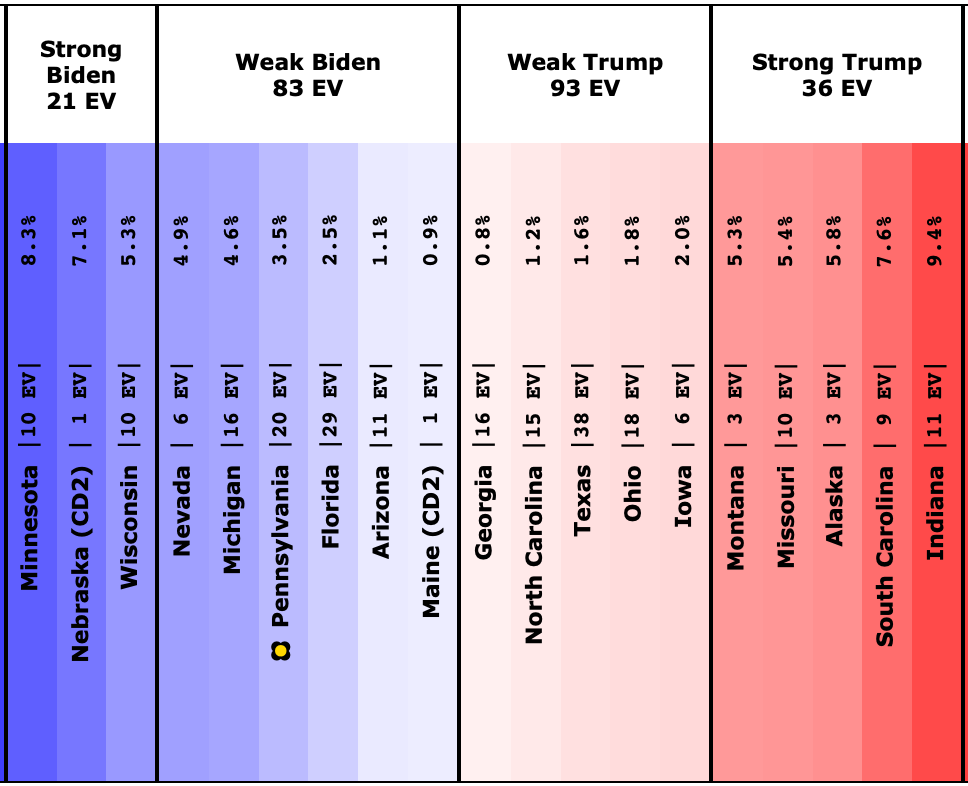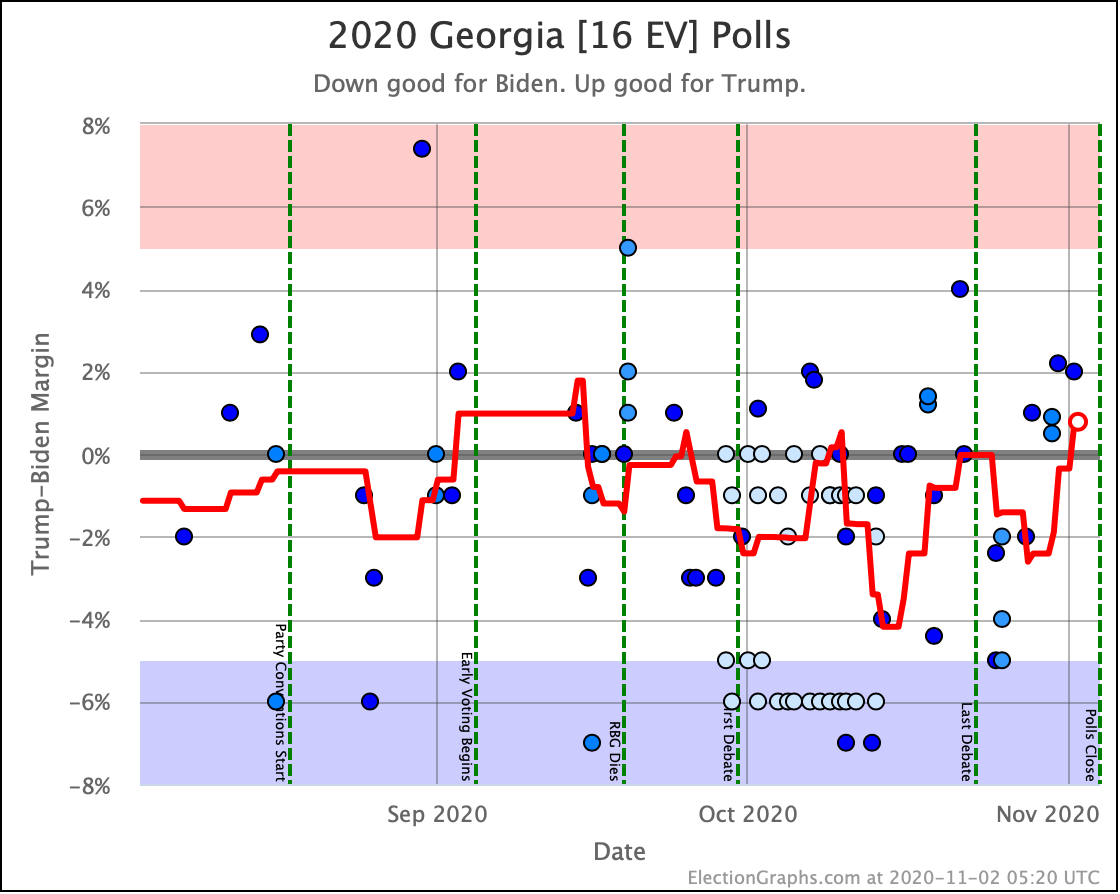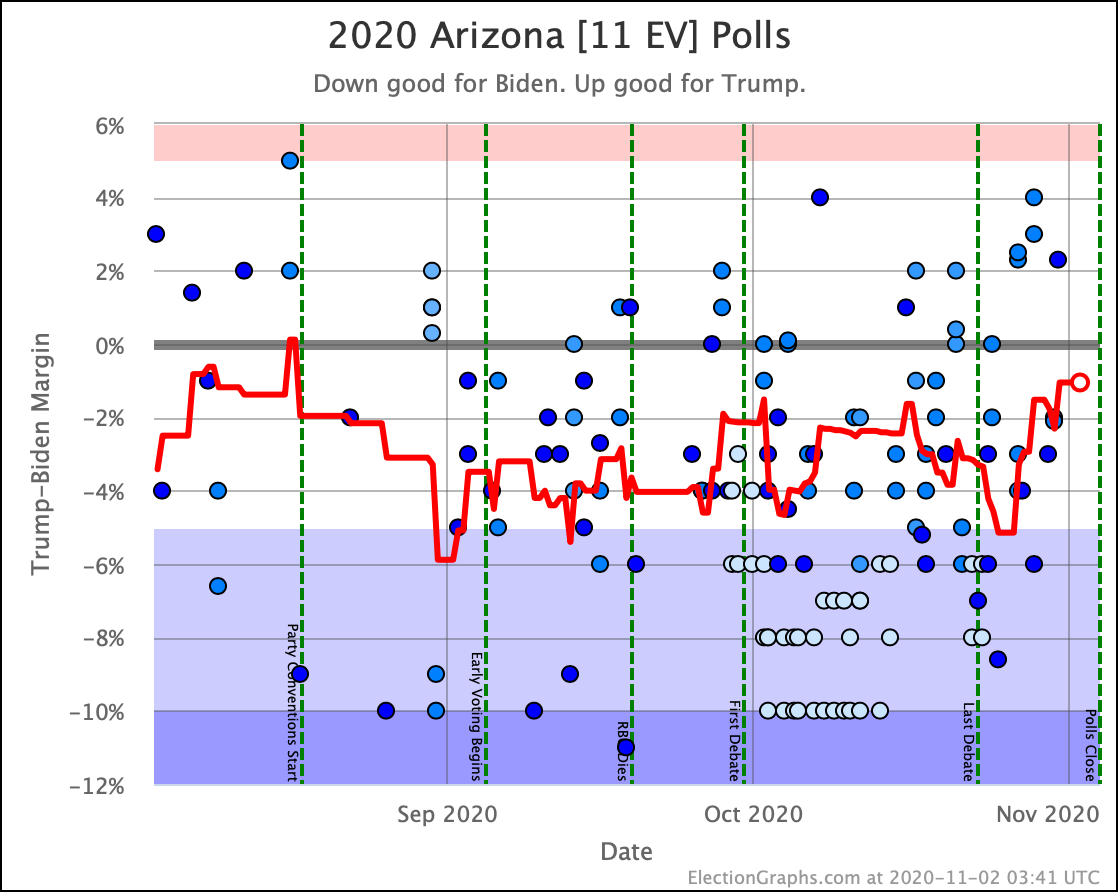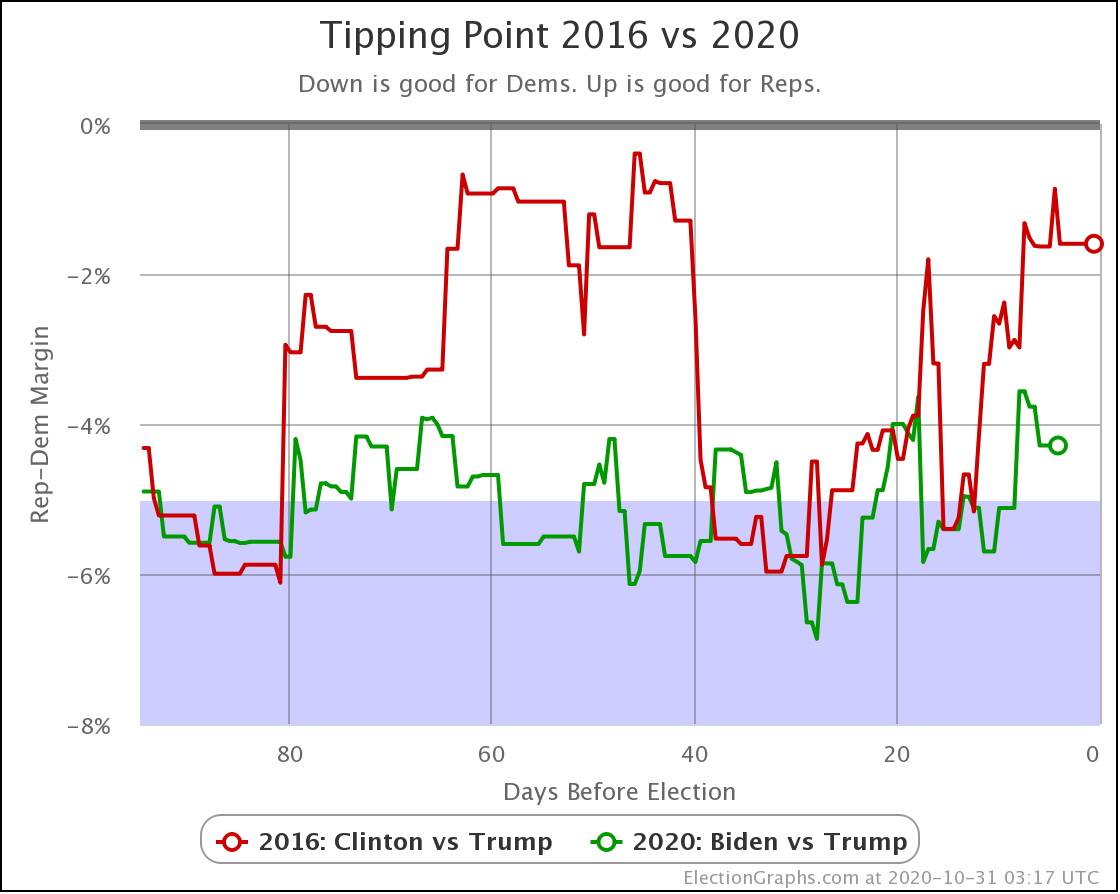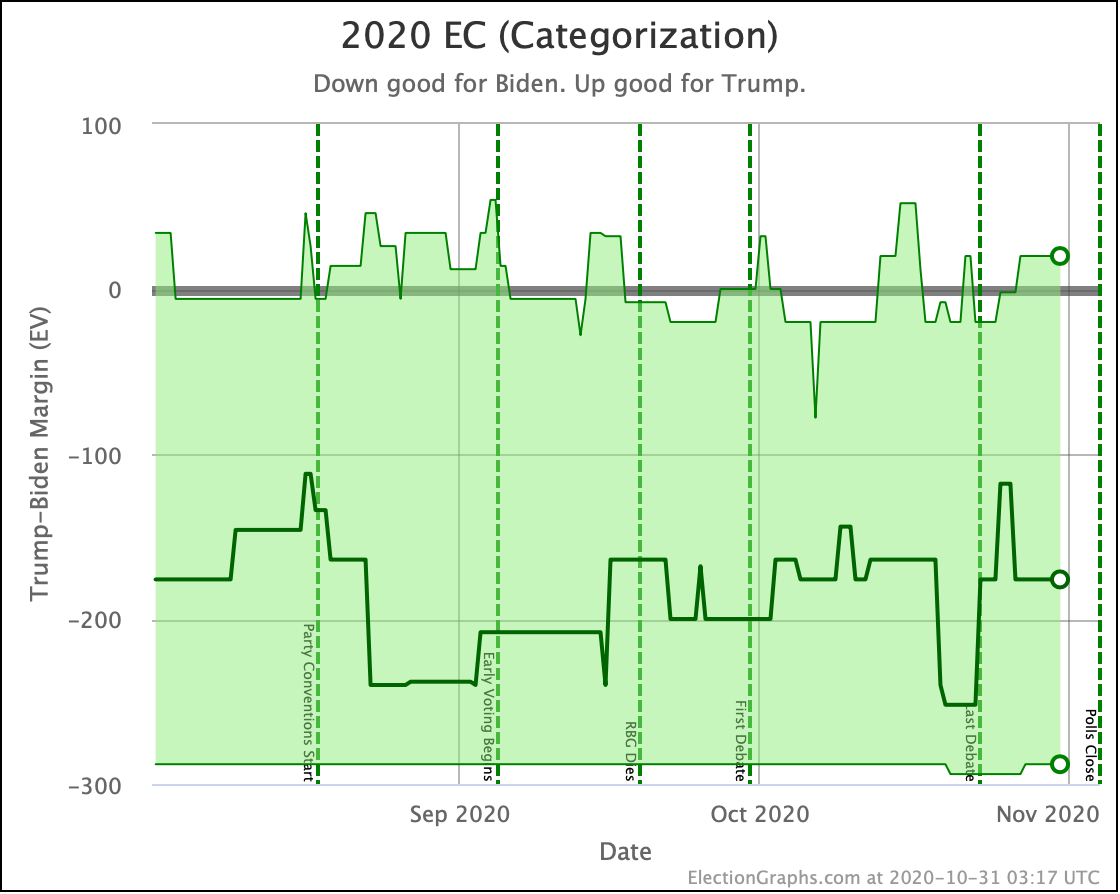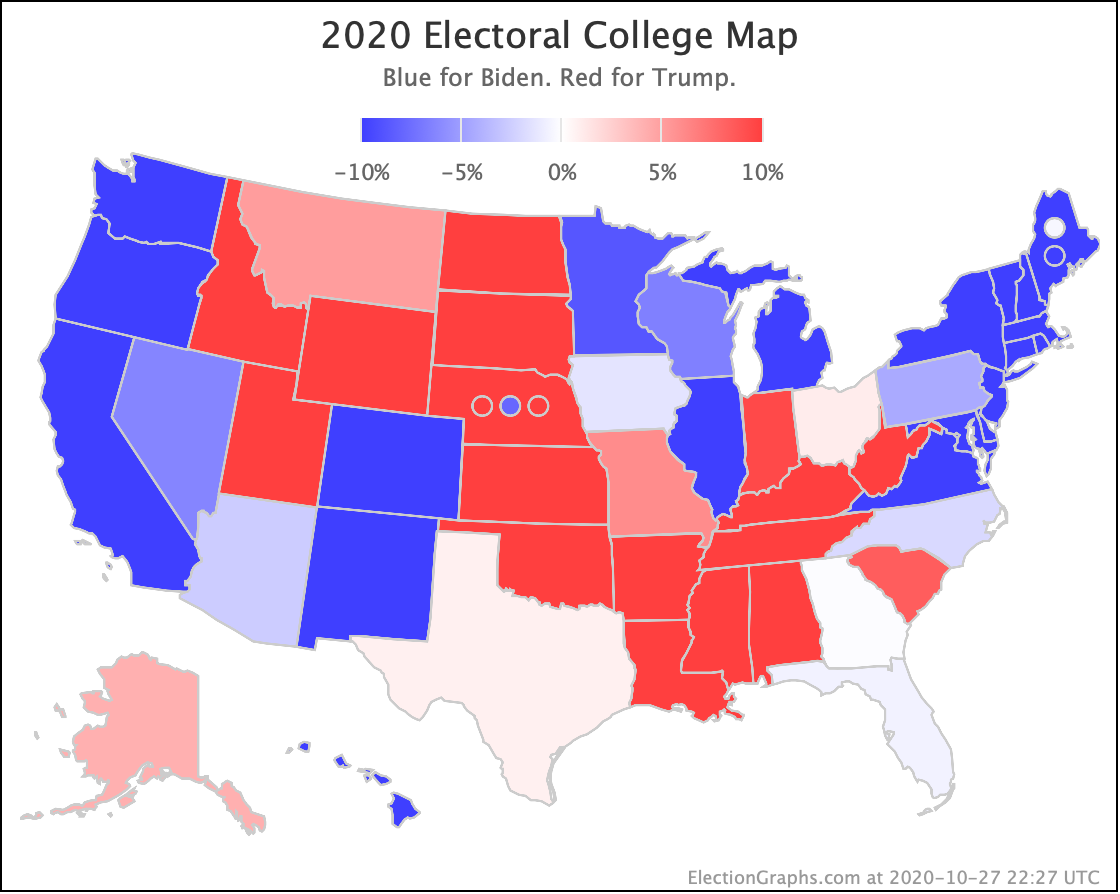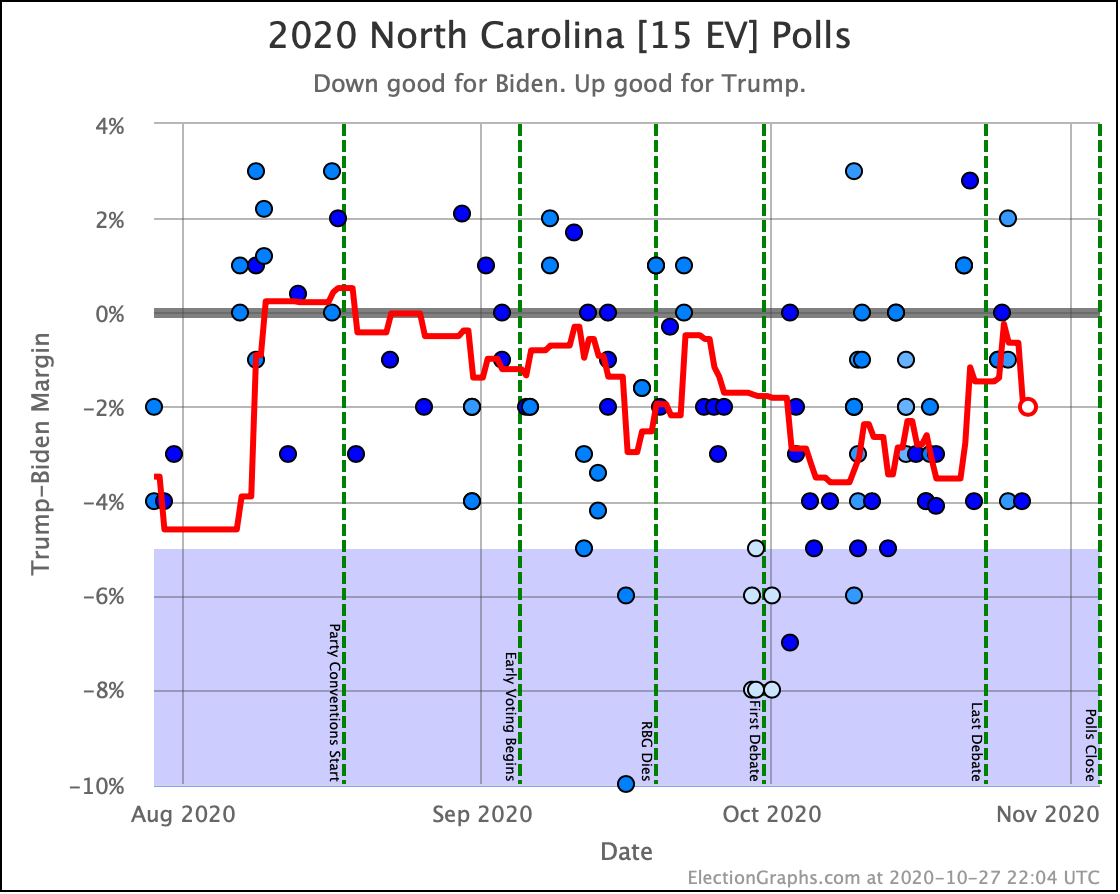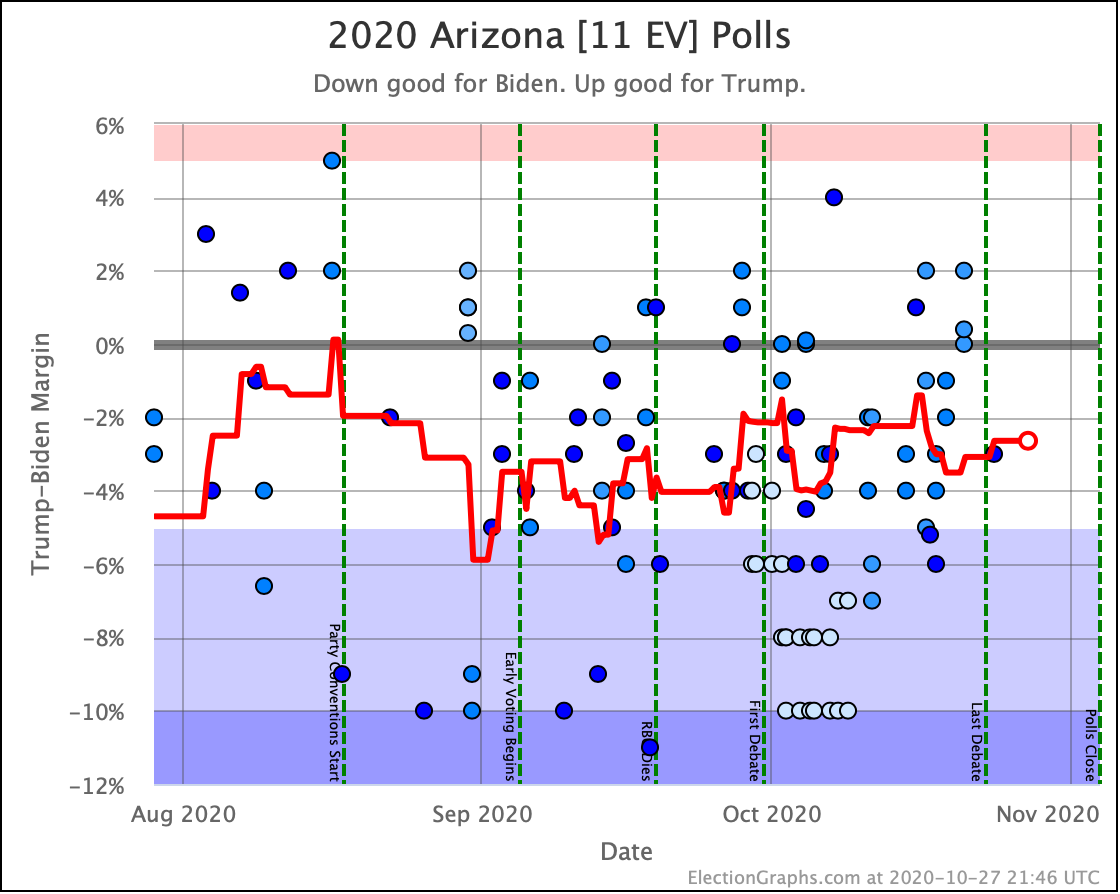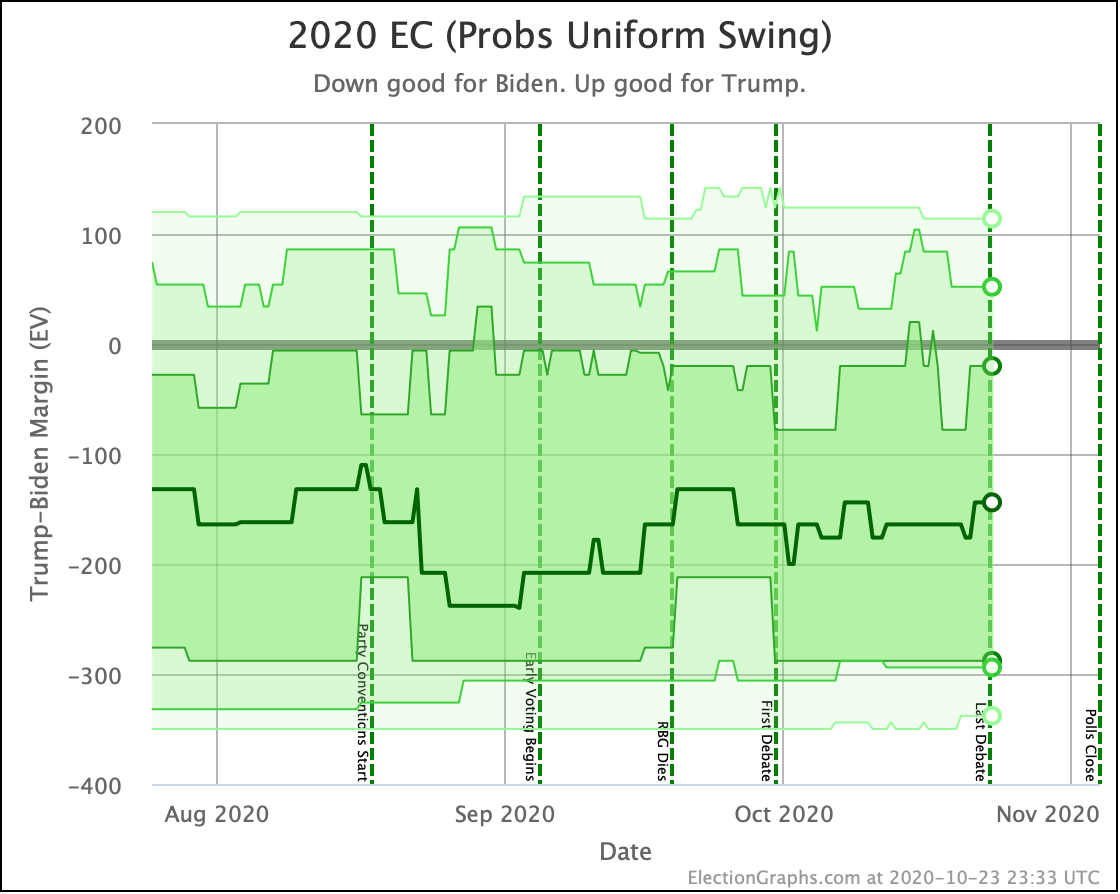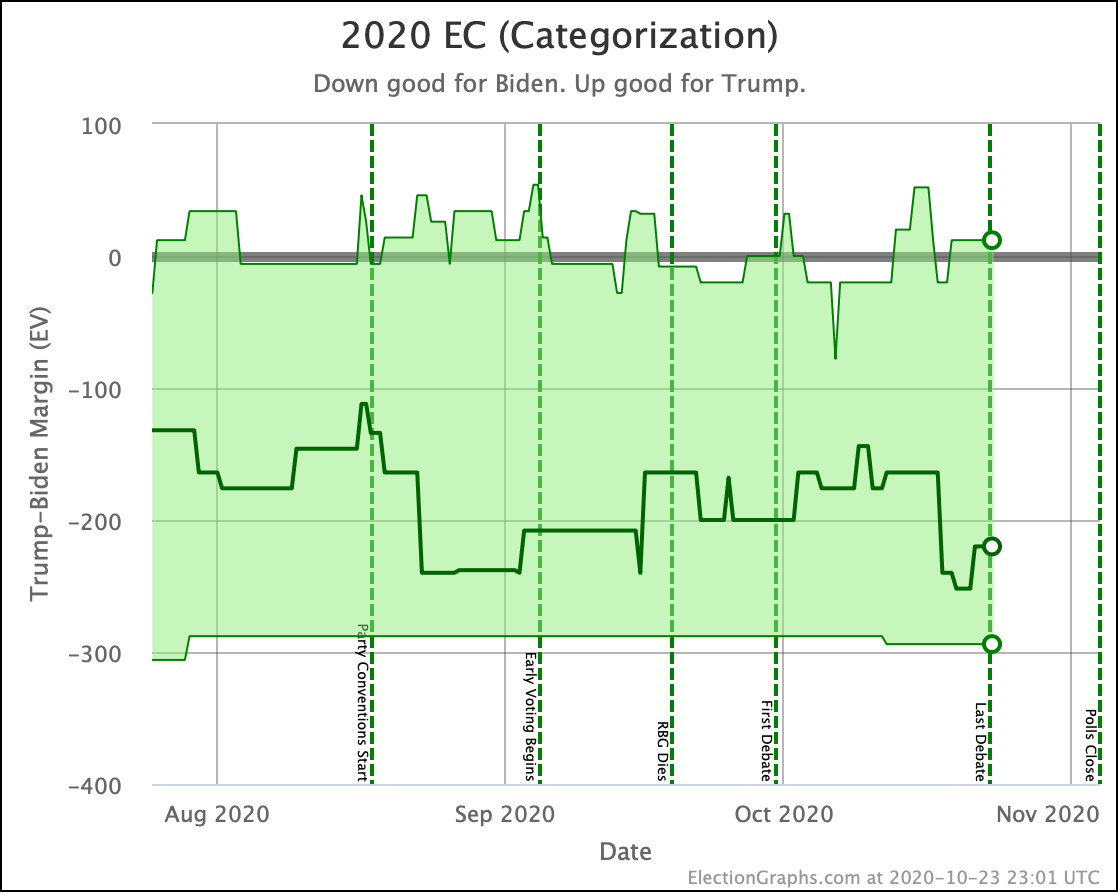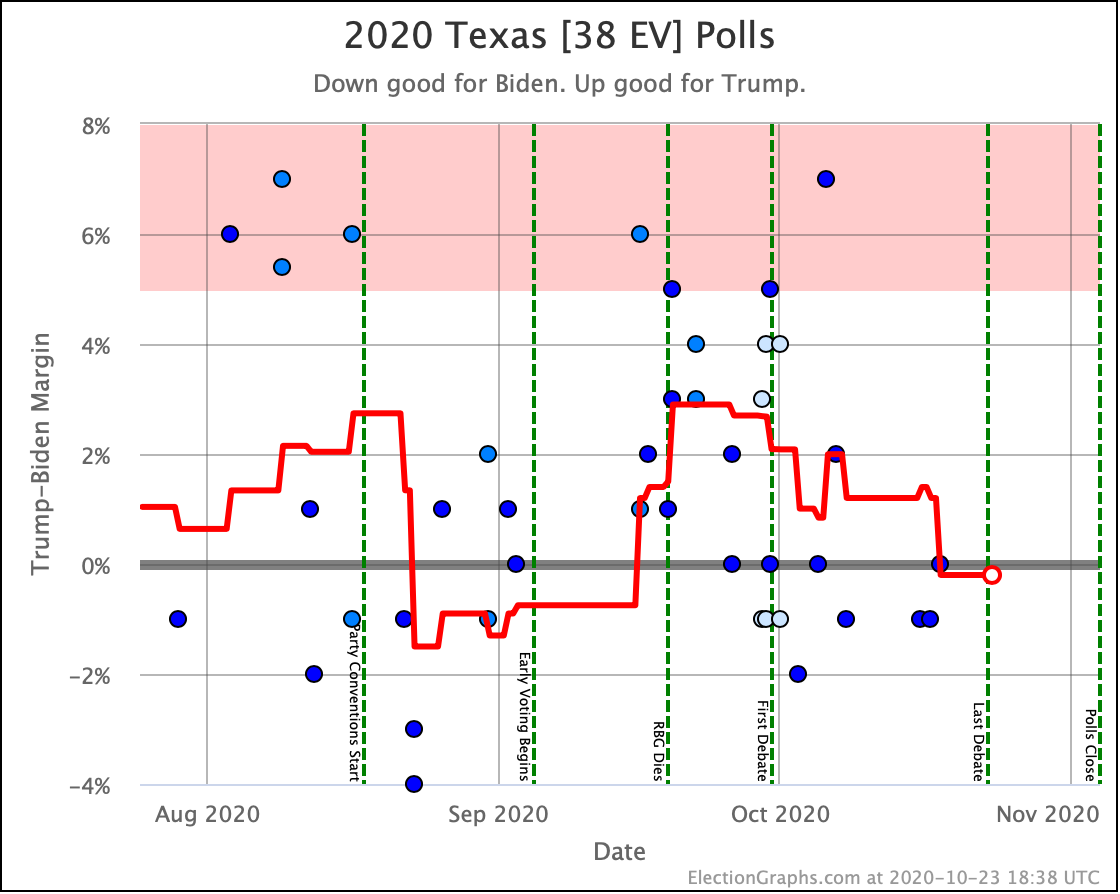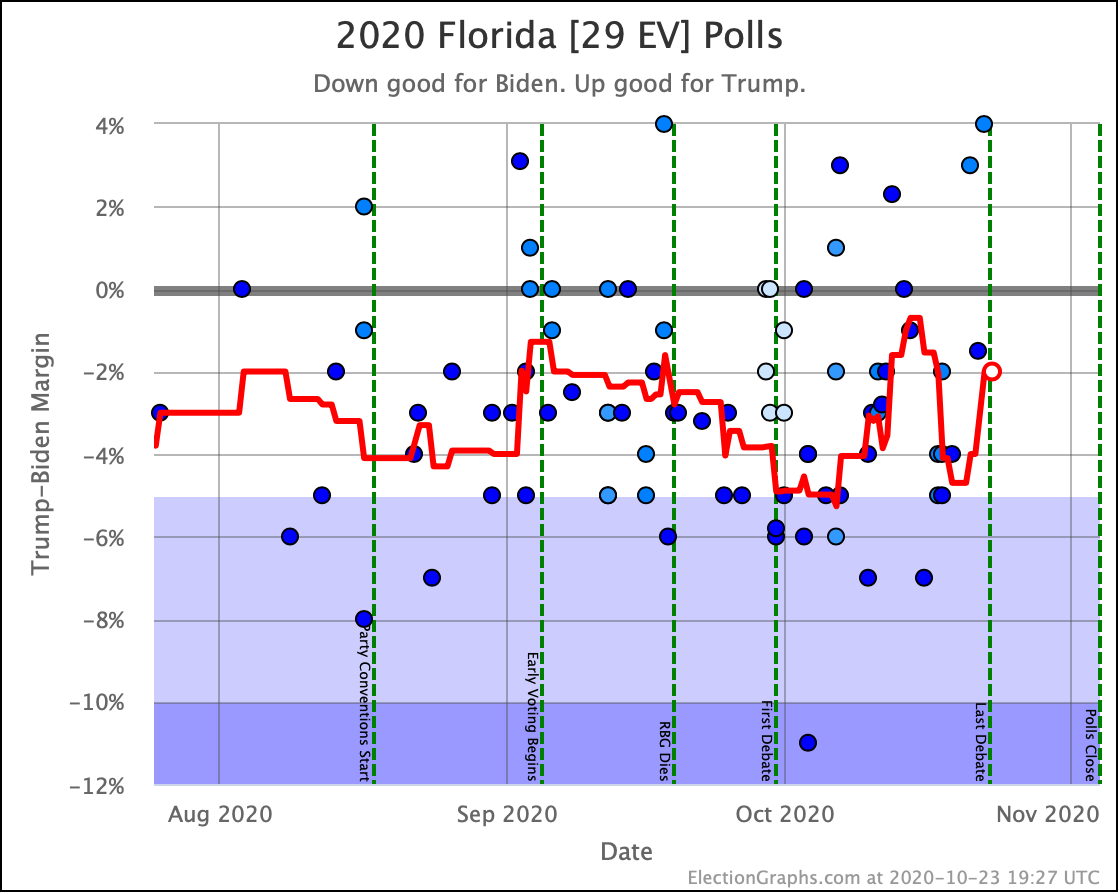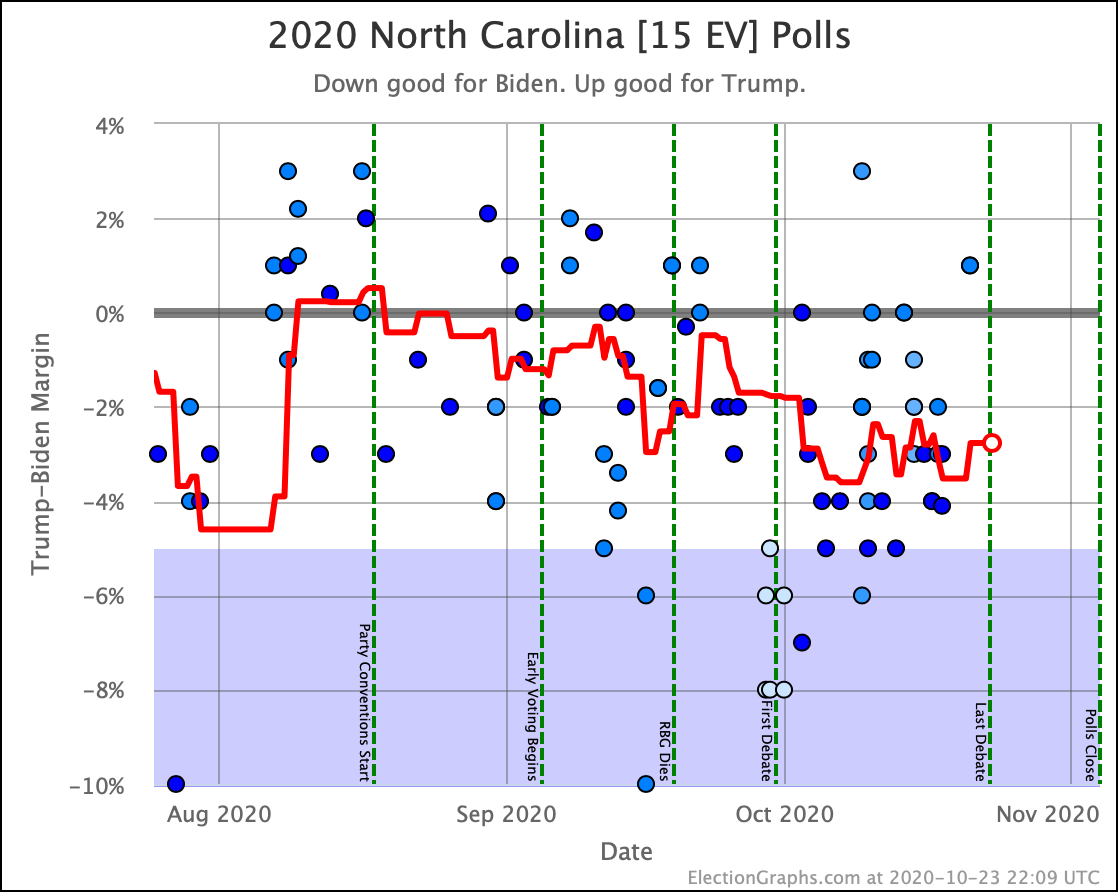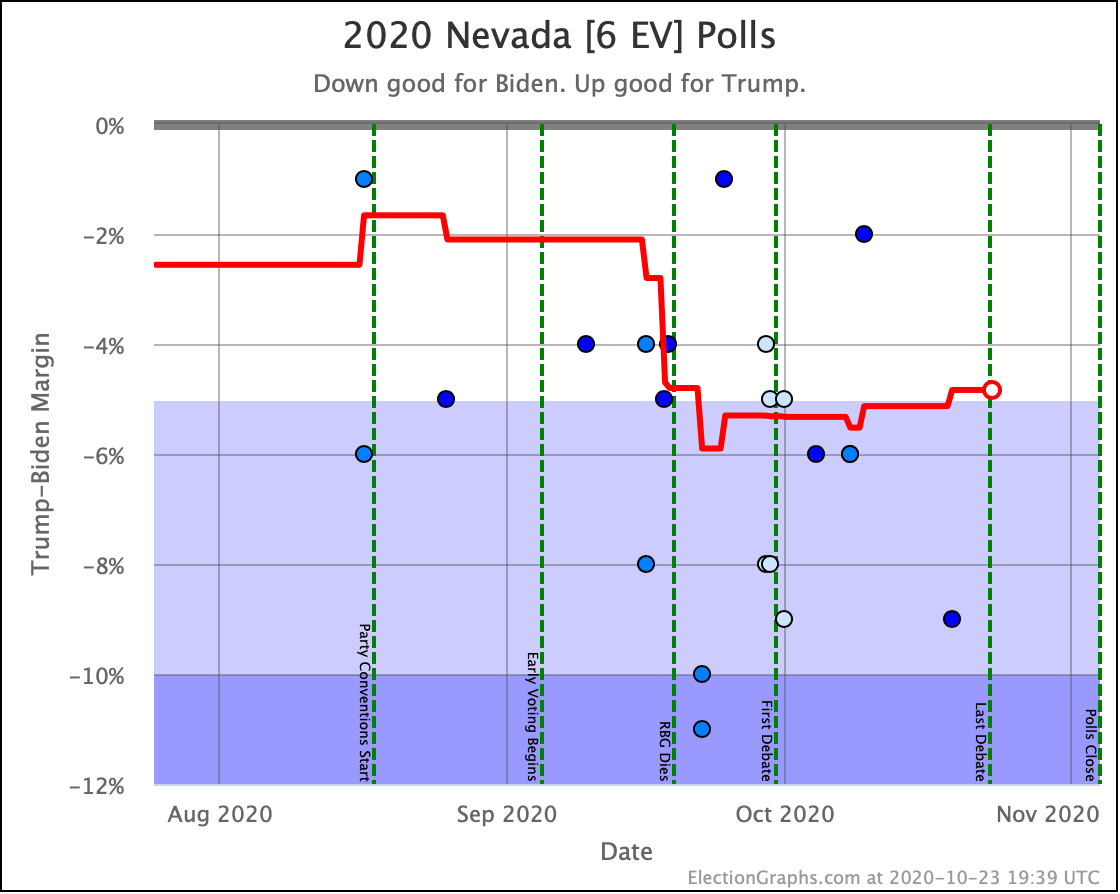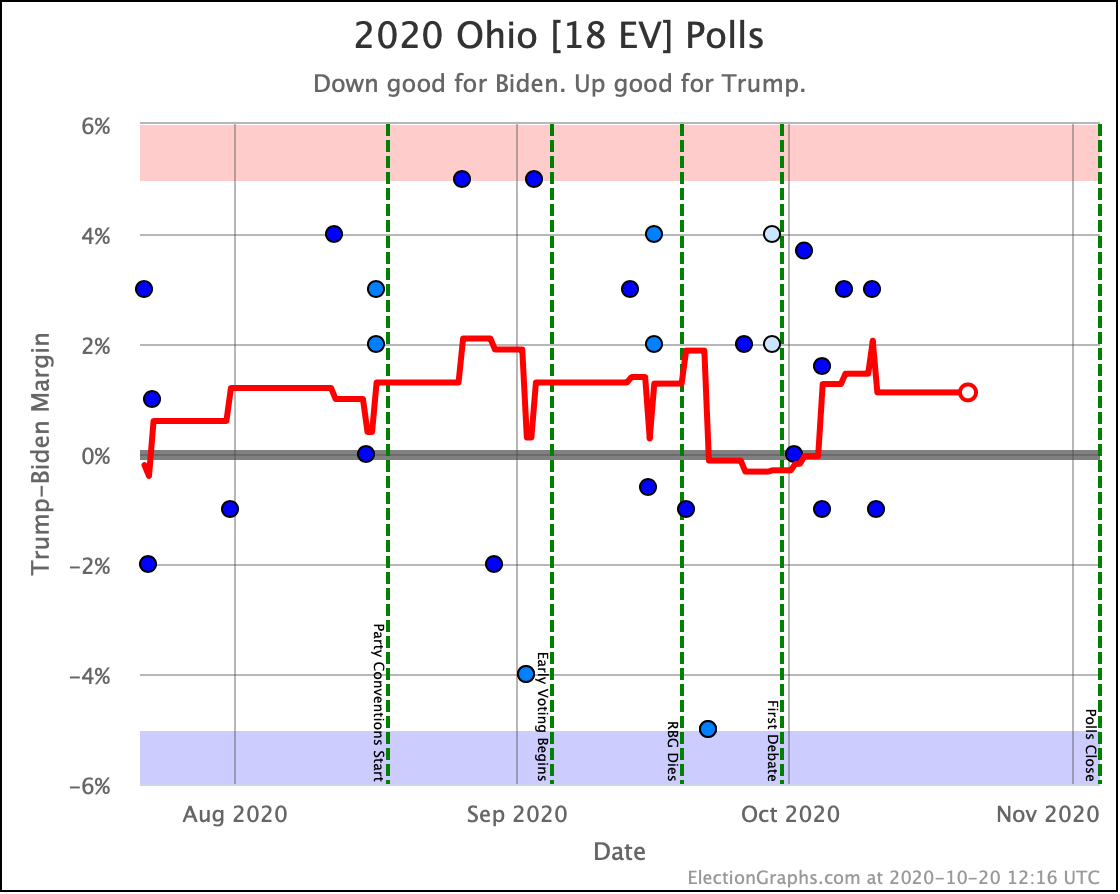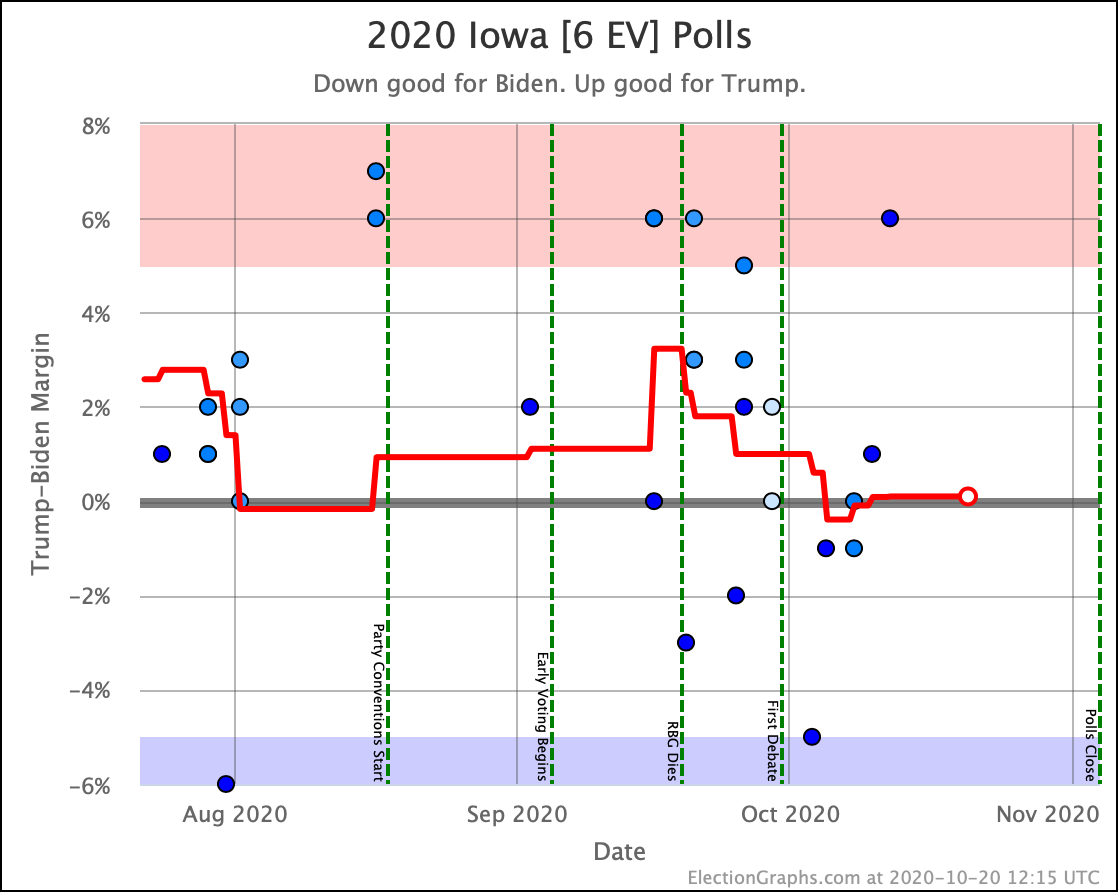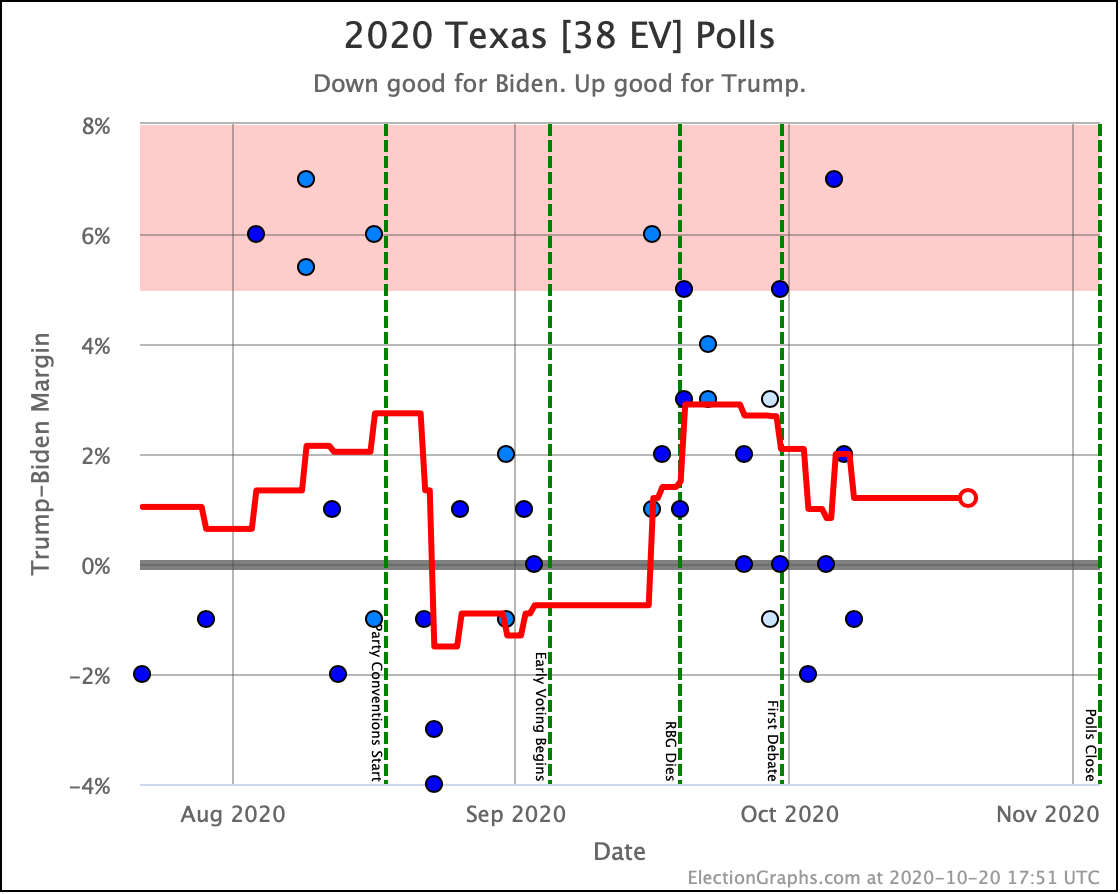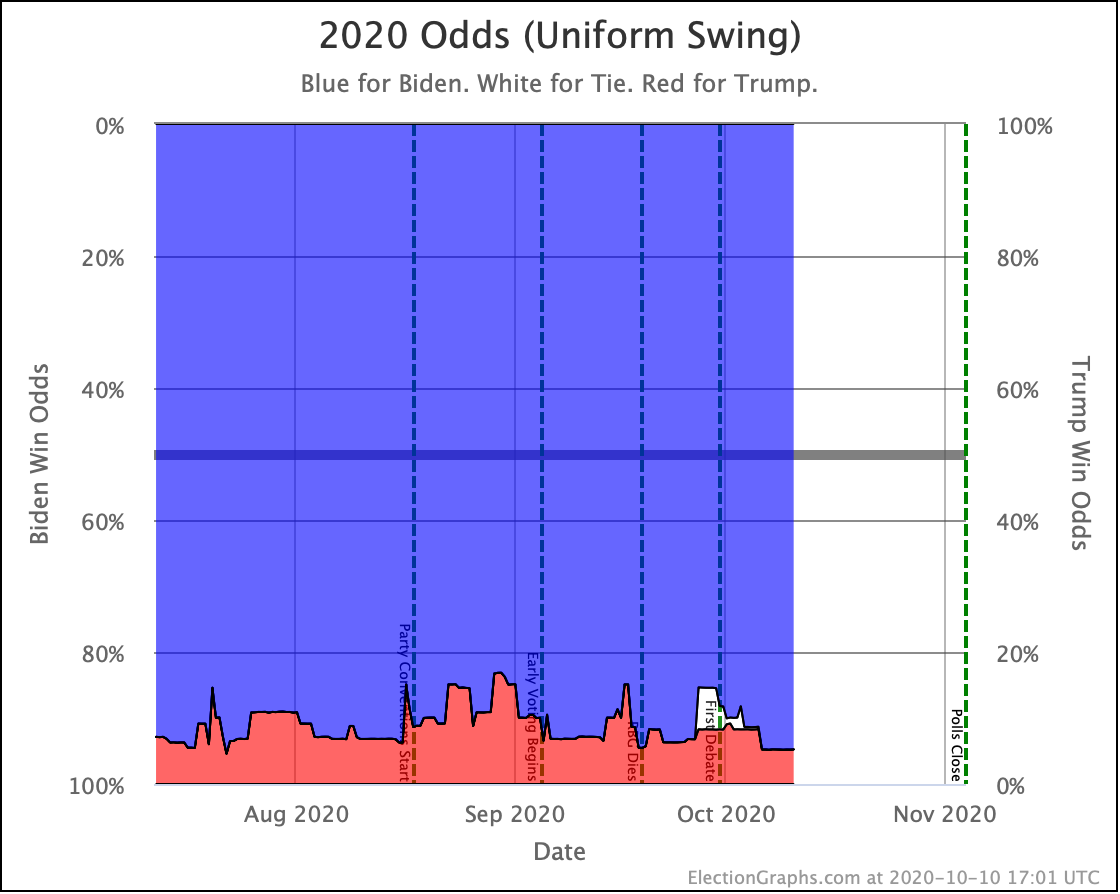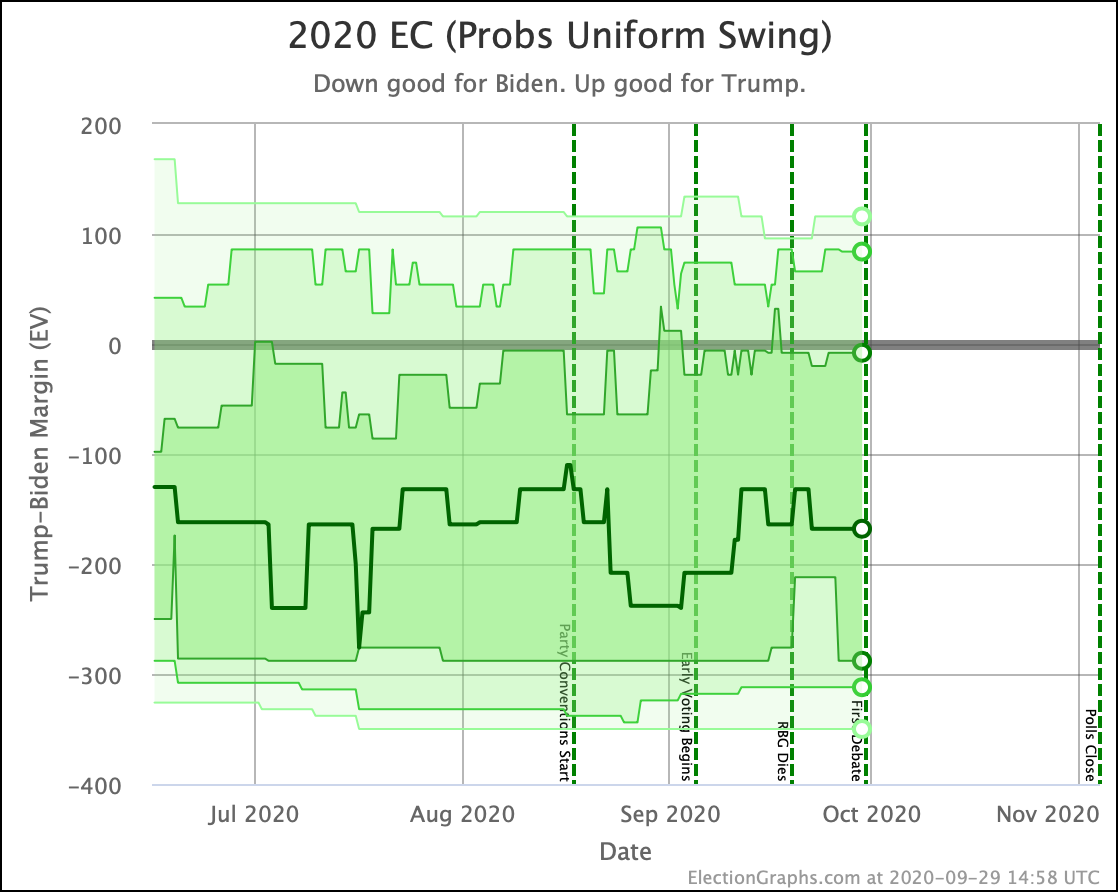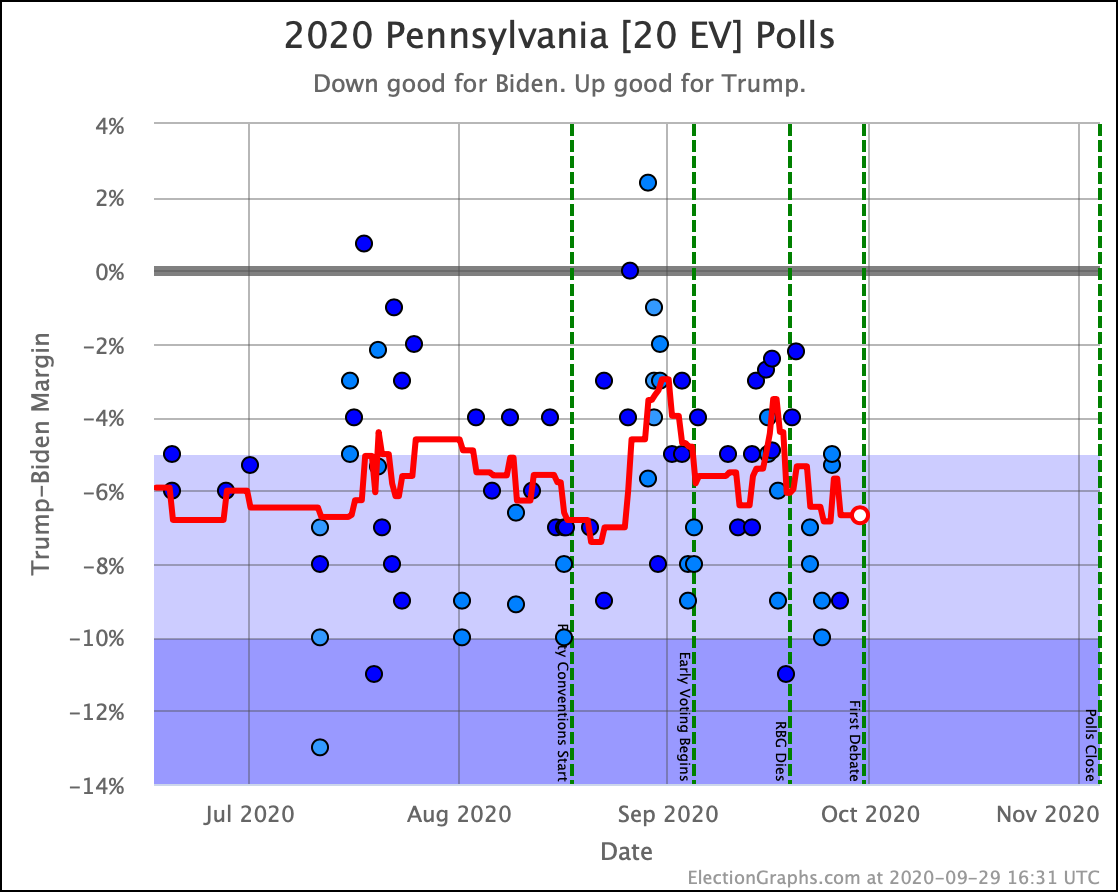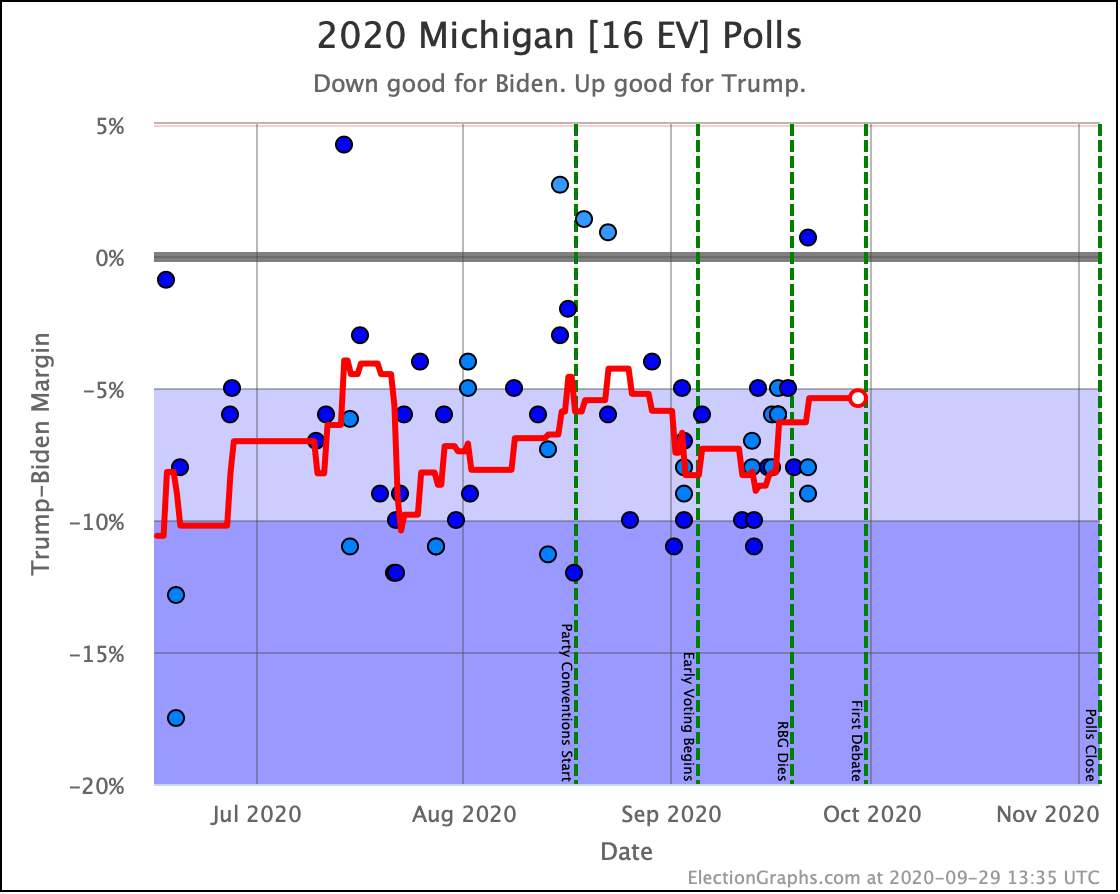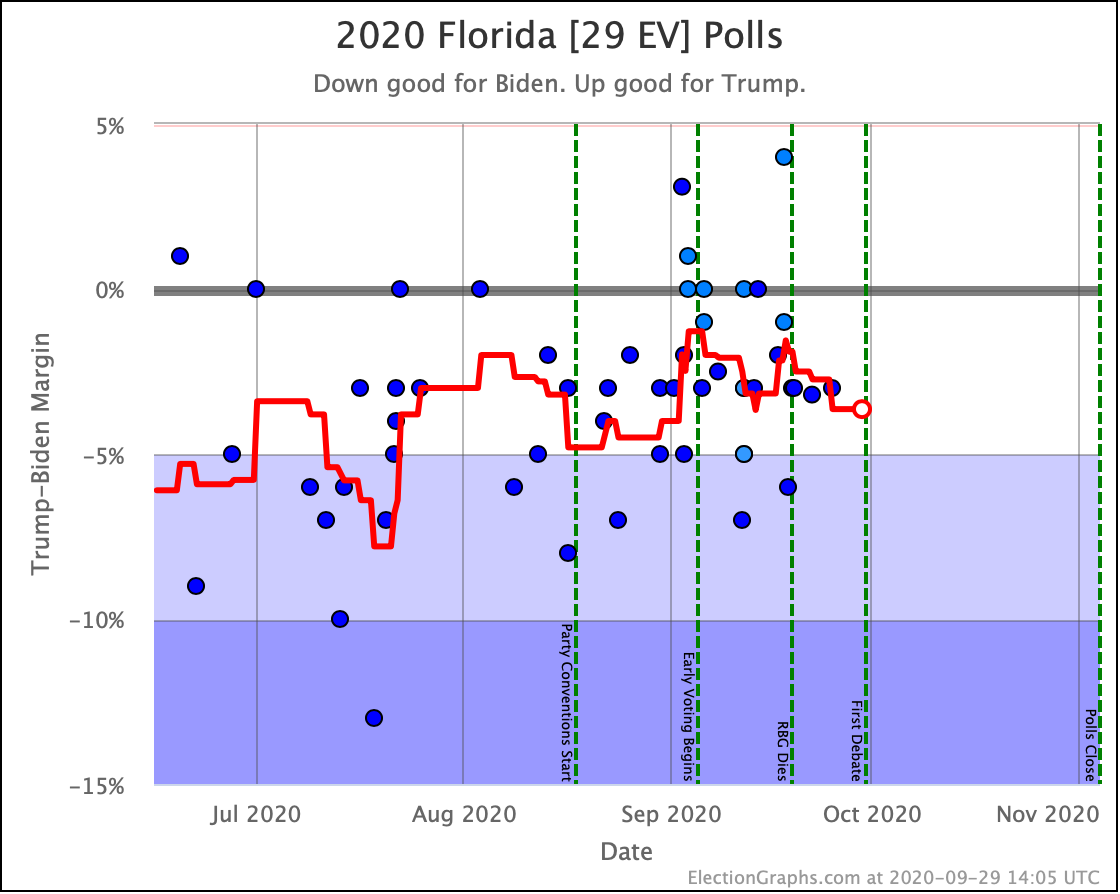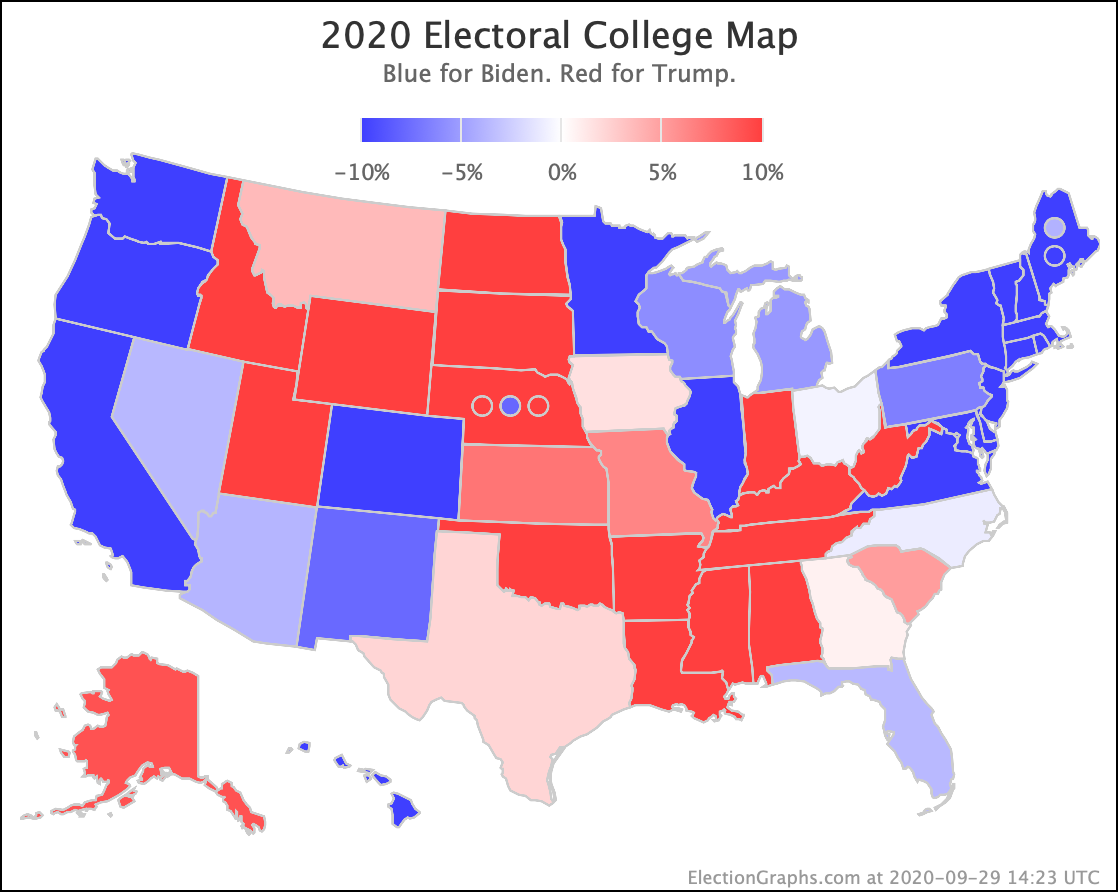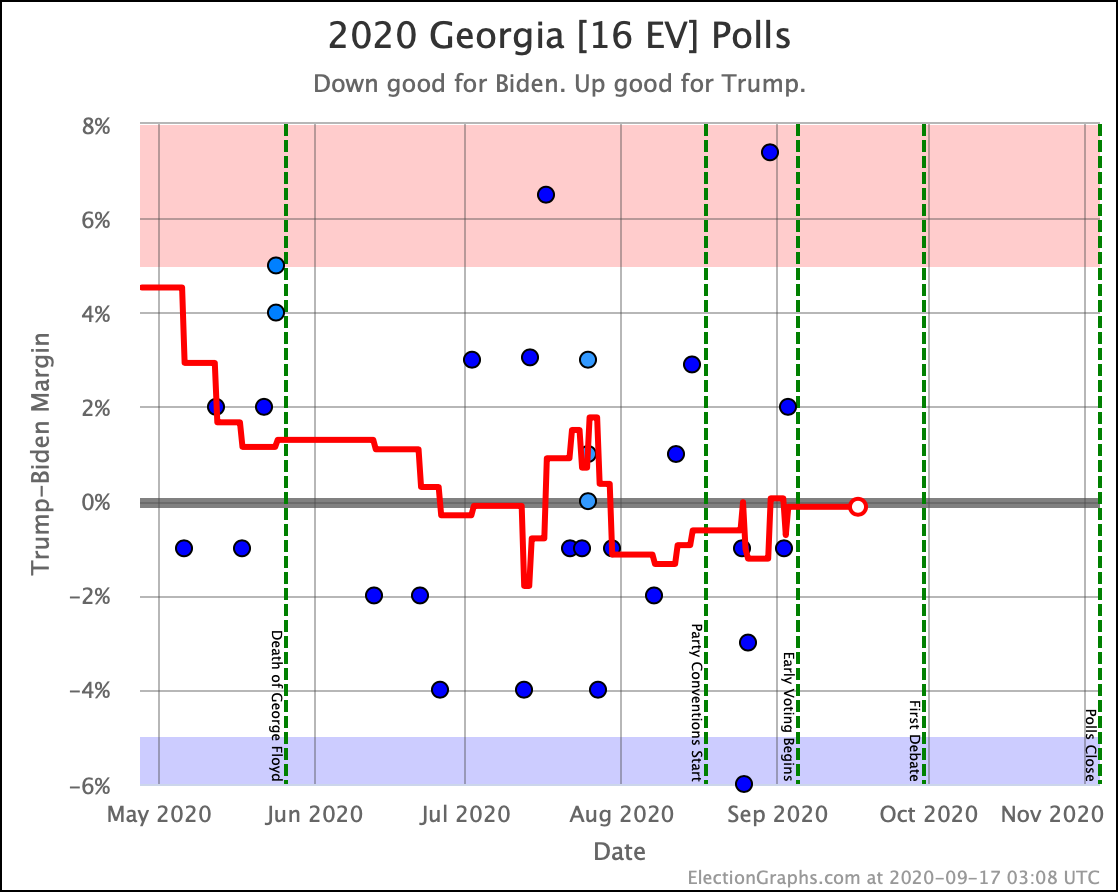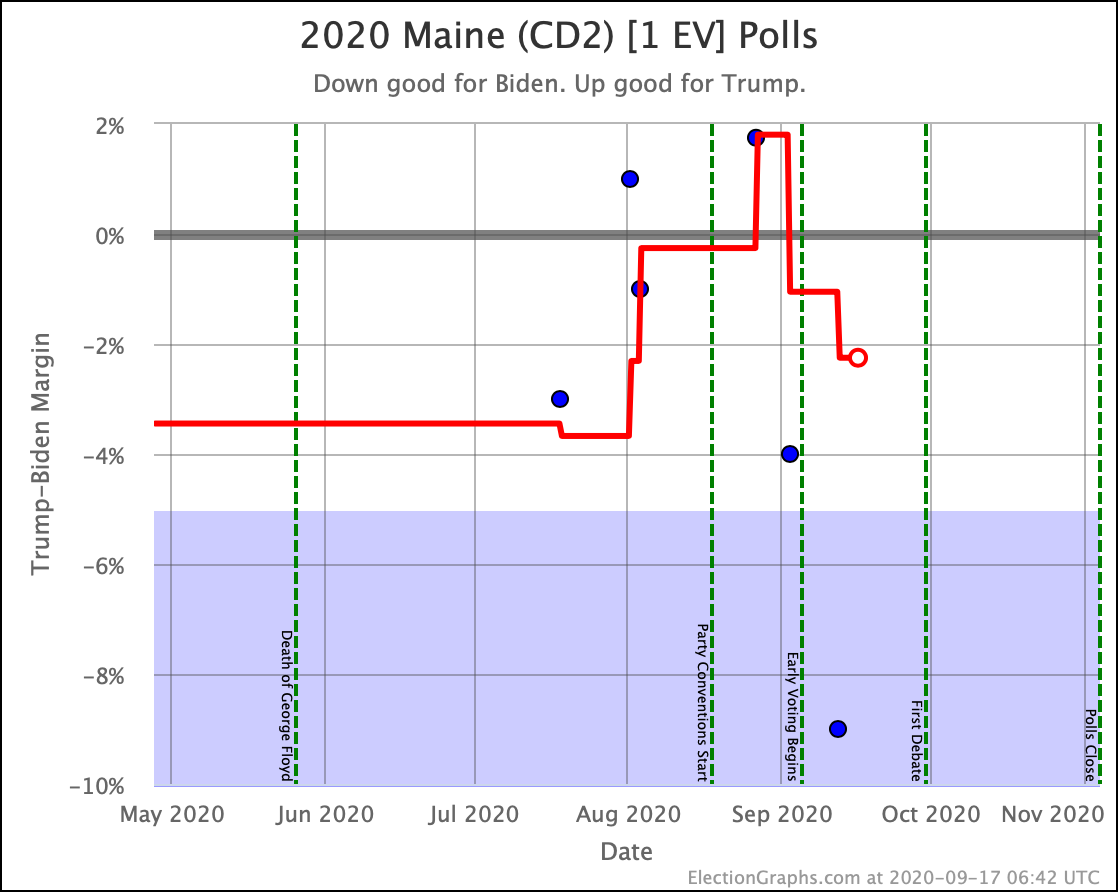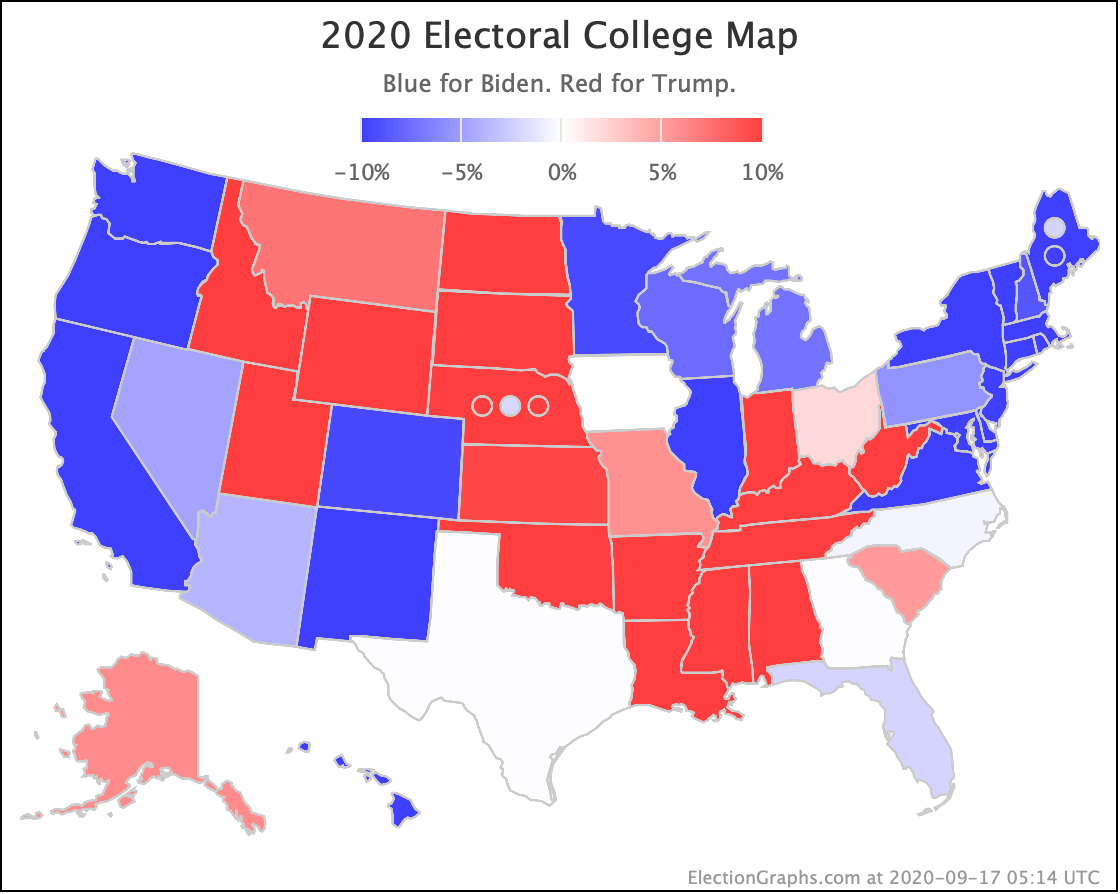As results start coming in, I'll update here with which states we got right, which we got wrong, and what that means for the range of possibilities based on the categorization view. I considered doing something where I updated the probabilistic numbers based on the called states, but that wouldn't really be a good model as the chances in the remaining states really should change based on which states have been called, and the vote count in the state, etc. And I'm not set up for any of that.
So we'll just stick to the best and worst cases for the candidates based on which states have been called, and assuming that only the "Weak" states might go the "wrong" way. Of course there can be surprises in the other categories too. We'll adjust appropriately if that happens.
Newer updates will be right under this introduction, scroll down for the older updates. Times listed are UTC. 0:00 UTC in November is 7 PM Eastern, 4 PM Pacific.
Refresh the page periodically to see updates.
2021-01-07 09:12 UTC
There were no faithless electors when the electoral college voted in December.
Despite a very eventful day in January when the electoral votes were presented to Congress, there were no changes to the totals.
So the final result is as expected since November 13th:
Biden 306 to Trump 232 – Biden by 74 electoral votes
At some point I'll start doing some analysis of the final state by state election results vs the final Election Graphs polling averages. I had hoped to actually do that by now. Oops.
I guess it is still fine as long as I do it before it is time to launch the 2024 version of this site, right?
Thanks again everybody for following us through the 2020 cycle.
2020-11-13 19:15 UTC
NBC just called Georgia for Biden. This is the last state that hadn't been called by anybody officially, although it has been clear for days that it was going that way.
So, final table:
| Biden | Trump | Margin | |
|---|---|---|---|
| Trump Best | 306 | 232 | Biden by 74 |
| Expected | 306 | 232 | Biden by 74 |
| Biden Best | 306 | 232 | Biden by 74 |
This leaves us with four jurisdictions where the final results differed from the Election Graphs calculations:
- Maine-CD2 was "Weak Biden" where Biden led by 2.7% in our averages, which gave Biden a 71.4% chance of winning in our estimation. Trump won though, so his 28.6% chance of winning paid off.
- Florida was also "Weak Biden" with an 0.7% lead. We translated this to only a 53.2% chance of a Biden win and a 46.8% chance of a Trump win. So Trump won this, but we had essentially identified it as a coin toss.
- North Carolina was "Weak Biden" with an 0.6% lead. We gave this as a 52.1% chance of a Biden win, and a 47.9% chance of a Trump win. Again, Trump won the coin toss.
- Georgia was "Weak Trump" with Trump's lead at 1.7%. For us that meant a 74.2% chance of a Trump win, and a 25.8% chance of a Biden win. In this case, Biden was the one who pulled off the underdog win.
All four of these places that went "the wrong way" were clearly in the zone where we gave significant odds to those states going the other way though, so none of them qualify as a huge surprise. So I am actually pretty satisfied with these results.
In addition, the "Biden by 74" EV was clearly within all of the "envelopes" this site produced, even if you go with the 1σ (68.27%) ranges for the two probabilistic views.
- The "Probabilistic Independent States" 1σ (68.27%) range went from Biden by 48 to Biden by 172 with a median of Biden by 108. This was the tightest of our three ranges, and Biden by 74 was clearly in that range.
- The "Probabilistic Uniform Swing" 1σ (68.27%) range was from Trump by 64 to Biden by 288 with a median of Biden by 132. Obviously Biden by 74 was in that range as well.
- And finally my old fashioned simple "Categorization View Best Cases" went from Trump by 64 to Biden by 288 with Biden by 132 if everybody just won all the states they led. An exact match for the Probabilistic Uniform Swing 1σ (68.27%) range. And Biden by 74 was of course in that range.
So I don't feel bad about these results at all. Yes, there is a lot of handwringing about how far polls were off, but with ranges and probabilities that were generated by looking at how far off polls have been in the past, you end up with views that give you a level of confidence given the historical accuracy, you get a sense of just how variable the results might be given by the polling we have. Bottom line is there is a lot of uncertainty. But you can measure that uncertainty.
Once all the counts in all the states are final and certified, I will do a more detailed look at the state by state polling errors and what patterns we see there. And of course we'll track if there are any faithless electors this time around. Look for posts on both of those topics in December most likely.
But for the moment, we have calls in every state, so we'll close out this post.
Thanks everybody for following us for the 2020 cycle!
2020-11-12 03:47 UTC
Lots of other places are now calling Arizona for Biden. But we moved it into the Biden column way back when Fox called it. So nothing changes here. We're only waiting on calls for Georgia, which is also expected to be Biden at this point absent some huge surprise.
2020-11-11 15:49 UTC
A couple of hours ago several outlets called Alaska for Trump. This does not change the matrix. The only state without a call is now Georgia, where Biden currently leads.
2020-11-10 18:50 UTC
DDHQ calls North Carolina for Trump. This is one where our averages had Biden slightly ahead, so it is the third place where Election Graphs had the wrong winner. Given the 0.6% Biden margin in the state though, we still gave Trump a 47.9% chance of winning the state, so once again, this was essentially a coin flip, so we don't feel too bad about the miss.
All three misses so far were "Weak Biden" states which ended up going Barely Trump though. If current counts hold, Georgia will be wrong in the other direction.
The new matrix:
| Biden | Trump | Margin | |
|---|---|---|---|
| Trump Best | 290 | 248 | Biden by 42 |
| Expected | 290 | 248 | Biden by 42 |
| Biden Best | 306 | 232 | Biden by 74 |
Only Georgia and Alaska left uncalled.
Note that because the Election Graphs poll average had Trump leading by 5.9%, which put it in our "Strong Trump" category, it is not included in the swing above. Based on current trends, that doesn't look likely to introduce a surprise.
So the results above depend only on the call in Georgia, where Biden is currently leading. But nobody has officially called it yet.
2020-11-07 16:43 UTC
And Fox calls Nevada for Biden. So the matrix tightens further:
| Biden | Trump | Margin | |
|---|---|---|---|
| Trump Best | 290 | 248 | Biden by 42 |
| Expected | 305 | 233 | Biden by 72 |
| Biden Best | 321 | 217 | Biden by 104 |
We're only talking about what Biden's margin is now. We've known Biden was the winner since 14:00 UTC yesterday. (Arguably even before that.) Some places are just slow officially making that conclusion.
2020-11-07 16:34 UTC
Looks like all the major news outlets simultaneously called Pennsylvania, and the whole election, when Biden's lead went over 0.5% a few moments ago. But we were past that point yesterday. Still no additional change to the matrix for us. We'd already moved PA to the Biden column.
Still waiting on media calls for Nevada, North Carolina, Georgia, and Alaska.
2020-11-06 14:30 UTC
Our "Expected" case in the table below is based on who led each state based on pre-election polling. If all the remaining states just go to the candidate who currently leads the vote count, which seems very reasonable based on current trends, you get Biden 306 to Trump 232, or Biden by 74 EV.
2020-11-06 14:00 UTC
DecisionDeskHQ just called PA for Biden as soon as Biden took the lead in that state. And that is that.
| Biden | Trump | Margin | |
|---|---|---|---|
| Trump Best | 284 | 254 | Biden by 30 |
| Expected | 305 | 233 | Biden by 72 |
| Biden Best | 321 | 217 | Biden by 104 |
Biden has won the Presidency. Only question now is by how much.
(And even if Arizona is uncalled, the Trump's best cases would still be Biden by 8, so it is still just a question of how big Biden's win is.)
2020-11-06 09:22 UTC
Biden just took the lead in Georgia, and it seems unlikely that will change given the trends. Pennsylvania is expected to flip to Biden in the next few hours too. But no official calls yet. So not changing the matrix yet.
Also worth noting that while Fox/AP/Bloomberg all called Arizona for Biden, and thus we adjusted out counts here to reflect that, all the other news outlets are holding back, because Trump is closing the gap as more ballots are counted. We'll leave that call reflected here unless those outlets actually retract their calls.
2020-11-04 21:25 UTC
CNN calling Michigan for Biden. Takes that off the table for Trump.
| Biden | Trump | Margin | |
|---|---|---|---|
| Trump Best | 264 | 274 | Trump by 10 |
| Expected | 305 | 233 | Biden by 72 |
| Biden Best | 321 | 217 | Biden by 104 |
2020-11-04 18:35 UTC
ME-CD2 gets called for Trump by AP. That was also “Weak Biden” with a Biden lead of 2.7%. Odds wise we said Trump had a 28.6% chance of winning ME-CD2. So along with Florida, this is the second "miss" relative to our categorizations, but both were states where the odds of a flip were high enough so it isn't a surprise. That's why these are "Weak".
New matrix:
| Biden | Trump | Margin | |
|---|---|---|---|
| Trump Best | 248 | 290 | Trump by 42 |
| Expected | 305 | 233 | Biden by 72 |
| Biden Best | 321 | 217 | Biden by 104 |
2020-11-04 17:13 UTC
Wisconsin election authorities say all votes are counted, and Biden is ahead. Of course, this was "Strong Biden" by the poll average, so it wasn't even supposed to be in contention, and it is actually close enough it could be in recount territory. For the moment, the matrix doesn't change though.
2020-11-04 06:14 UTC
DDHQ calls NE-CD2 for Biden. It was Strong Biden, so expected.
2020-11-04 05:29 UTC
Montana called for Trump, no surprise.
2020-11-04 05:22 UTC
Fox/AP call Iowa for Trump. Takes it off as a possible Biden pickup:
| Biden | Trump | Margin | |
|---|---|---|---|
| Trump Best | 248 | 290 | Trump by 42 |
| Expected | 306 | 232 | Biden by 74 |
| Biden Best | 322 | 216 | Biden by 106 |
2020-11-04 05:15 UTC
Minnesota goes to Biden as expected.
2020-11-04 05:05 UTC
Hawaii goes where you expect.
2020-11-04 04:55 UTC
Fox calls Texas for Trump. So that's off the Biden pickup list.
| Biden | Trump | Margin | |
|---|---|---|---|
| Trump Best | 248 | 290 | Trump by 42 |
| Expected | 306 | 232 | Biden by 74 |
| Biden Best | 321 | 210 | Biden by 118 |
2020-11-04 04:46 UTC
Fox calls Ohio for Trump. Takes it off the possible pick up list for Biden.
| Biden | Trump | Margin | |
|---|---|---|---|
| Trump Best | 248 | 290 | Trump by 42 |
| Expected | 306 | 232 | Biden by 74 |
| Biden Best | 366 | 172 | Biden by 194 |
2020-11-04 04:23 UTC
Fox calls Arizona for Biden. That was a "Weak Biden", so not a flip, but takes it off the table for Trump's best case. New matrix:
| Biden | Trump | Margin | |
|---|---|---|---|
| Trump Best | 248 | 290 | Trump by 42 |
| Expected | 306 | 232 | Biden by 74 |
| Biden Best | 384 | 154 | Biden by 230 |
2020-11-04 04:08 UTC
Idaho goes the way you would thing.
2020-11-04 04:02 UTC
Washington, Oregon, California for Biden.
2020-11-04 03:52 UTC
NBC calls Nebraska, EXCEPT the 2nd.
2020-11-04 03:35 UTC
Louisiana, Utah, and Kansas called the way you would expect.
New Hampshire too.
2020-11-04 02:30 UTC
NBC calls North Dakota for Trump.
2020-11-04 02:10 UTC
And AP calls Wyoming for Trump.
And New Mexico and Colorado for Biden
NBC calls South Dakota for Trump.
2020-11-04 02:05 UTC
Biden gets New York. Shocker.
2020-11-04 01:40 UTC
Arkansas for Trump. No surprise.
2020-11-04 01:30 UTC:
Missouri for Trump, no surprise.
ME-CD1 and ME-All to Biden. No surprise.
2020-11-04 01:20 UTC
DDHQ calls Florida for Trump. That had been "Weak Biden". First wrong state of the day.
New chart:
| Biden | Trump | Margin | |
|---|---|---|---|
| Trump Best | 237 | 301 | Trump by 64 |
| Expected | 306 | 232 | Biden by 74 |
| Biden Best | 384 | 154 | Biden by 230 |
2020-11-04 01:15 UTC
Massachusetts and Maryland and Delaware and DC and New Jersey to Biden. No surprises. Illinois and Connecticut too. Rhode Island.
Trump gets Alabama, Oklahoma, Mississippi, and Tennessee
Still no states that were actually in question.
2020-11-04 01:00 UTC
AP says Trump in South Carolina. No surprise.
2020-11-04 00:15 UTC
Fox calls Virginia and Vermont for Biden. Also no surprises.
AP calls Kentucky for Trump. No surprise.
DHQ calls West Virginia for Trump. No surprise.
I'll only put in a new matrix if it changes.
2020-11-04 00:05 UTC
Indiana for Trump. It was Strong Trump, so no surprise and no change to the matrix.
| Biden | Trump | Margin | |
|---|---|---|---|
| Trump Best | 237 | 301 | Trump by 64 |
| Expected | 335 | 203 | Biden by 132 |
| Biden Best | 413 | 125 | Biden by 288 |
2020-11-03 23:00 UTC
No states called yet.
| Biden | Trump | Margin | |
|---|---|---|---|
| Trump Best | 237 | 301 | Trump by 64 |
| Expected | 335 | 203 | Biden by 132 |
| Biden Best | 413 | 125 | Biden by 288 |



